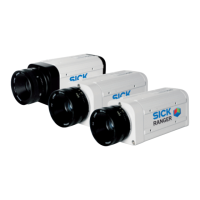Reference Manual Chapter 2
Ranger E/D
©SICK AG • Advanced Industrial Sensors • www.sick.com • All rights reserved 9
Overview
To get calibrated measurements – for example coordinates and heights in millimeters –
you need to transform the sensor coordinates (row, column, profile id) into world coordi-
nates (x, y, z). This transformation depends on a number of factors, for example the dis-
tance between the Ranger and the object, the angle between the Ranger and the laser,
and properties of the lens. You can do the transformation yourself, or you can use the
3D Camera Coordinator – a tool that performs the transformation from sensor coordinates
(row, column) to world coordinates (x, z). The world coordinate in the movement direction
(y) is obtained by the use of an encoder. For more information about the Coordinator tool,
see the 3D Camera Coordinator Reference Manual.
In a machine vision system, the Ranger acts as a data streamer. It is connected to a PC
through either a CameraLink connection (Ranger C) or a Gigabit Ethernet network (Ran-
ger D & E). The Ranger sends the profiles to the computer, and the computer runs a
custom application that retrieves the profiles and processes the measurement data in
them. This application can for example analyze the data to find defects in the objects and
control a lever that pushes faulty objects to the side.
Before the Ranger can be used in a machine vision system, the following needs to be
done:
Find the right way to mount the Ranger and light sources.
Configure the Ranger to make the proper measurements.
Write the application that retrieves and processes the profiles sent from the Ranger.
The application is developed in for example Microsoft Visual Studio, using the APIs that
are installed with the Ranger development software.
Figure 2.2 – Profiles are sent from the Ranger to a PC, where they are analyzed by a
custom application.
2.2 Mounting the Ranger
Selecting the right way of illuminating the objects to measure, and finding the right way in
which to mount the Ranger and lightings are usually critical factors for building a vision
system that is efficient and robust.

